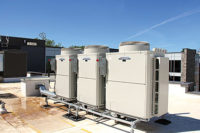An imposing building in downtown Little Rock, the Arkansas State Capitol is a smaller-scale replica of the nation’s capitol in Washington. Having been home to the Arkansas legislature since 1911, the State Capitol was designed long before hvac systems were either an architectural or engineering concern.
But when the need for a new system became evident, the age and design of the building (nearly a century old) could not be used as an excuse for installing a new system with less-than-optimum comfort and indoor air quality.
The powers that be within the Secretary of State’s office wanted a system that offered flexibility, reliability, and energy efficiency. It was also essential to keep a close eye on the budget, especially since the public’s eye is often focused on such a high-profile political landmark.
The challenge of finding a solution went to a locally based hvac consulting firm, Goodman Engineers.
The objective was to replace an existing fancoil system with a high-efficiency, vav central-station system. Because space constraints and budget limitations were two of the most important considerations in satisfying the job’s requirements, Goodman Engineers recommended a modular system design.
Two air handlers (Vision™ CAH 050 units from McQuay International), each of which delivers nearly 25,000 cfm, are the backbone of the system.
“We chose [these] air handlers because they gave us the flexibility and quality we needed at the price we needed,” said Mark Eakin, P.E., project manager, Goodman Engineers, at the time of the construction.
Custom-modular platform
“These air handlers feature a custom-modular platform, which not only allowed us to choose from a wide selection of components and sizes, but also to design a semi-customized solution at prices much lower than a fully customized system would have cost to install,” he added.“The Vision can also be shipped completely assembled or by section, which was an important consideration because size and space constraints would have made it virtually impossible to install the air handlers if they were preassembled.”
Certified Mechanical Inc. (CMI), also of Little Rock, handled the installation, which involved the largest of the air handlers. “These units are so big there was no choice but to ship them in sections,” said Mike Tygart, vice president of CMI. “But because of their modular construction, assembling them on site was a breeze.”
The air handlers were not installed in existing space within the Arkansas State Capitol. Instead, a new mechanical room was built on the west side of the building, 20 ft below the ground, and later covered over with a parking lot.
“The hardware for each unit was included, along with the instructions,” said Tygart. “All it took was sliding the modules together, connecting the gasketed splice collars, and fastening a few bolts.”
According to Tygart, the installation went smoothly, except for a minor mishap. “One of the coil modules was crushed during shipment, and we had to order a replacement. But again, the modular design made it easy to remove the damaged section and slide the new one in place.”
CMI was charged to complete the installation within a tight turnaround time — before the state legislature convened in the fall. But even with the need to replace the damaged coil, the air handlers’ modular design made it possible to assemble the system in a short time frame.
It will also make it easier to assemble new units in the future. The Arkansas State Capitol’s hvac system upgrade is a multistage project, and the state has plans for two more air handlers during a later phase.
Sidebar: Flexibility offers contractors options
Jim Olsen, marketing manager for McQuay’s Vision and coil product lines, says the key benefit of the Arkansas State Capitol system — flexibility — is becoming an increasingly important feature, not only for air handlers, but for hvac systems in general.This is an important consideration for hvac contractors and system designers.
“With more than 50% of the buildings in the United States built before the 1970s and as much as 70% of the existing inventory dating from the 1980s, space constraints are often a major obstacle in retrofit jobs,” Olsen said.
“And when you consider the growing pressure to link legacy hvac systems with building automation and other in-house systems that often require communication with technologies that didn’t even exist when the hvac system was originally installed, the need for flexibility in design and engineering is even more apparent.
“As a result, we believe flexibility will play a much more significant role in influencing future hvac purchase decisions than it has traditionally done in the past.”





